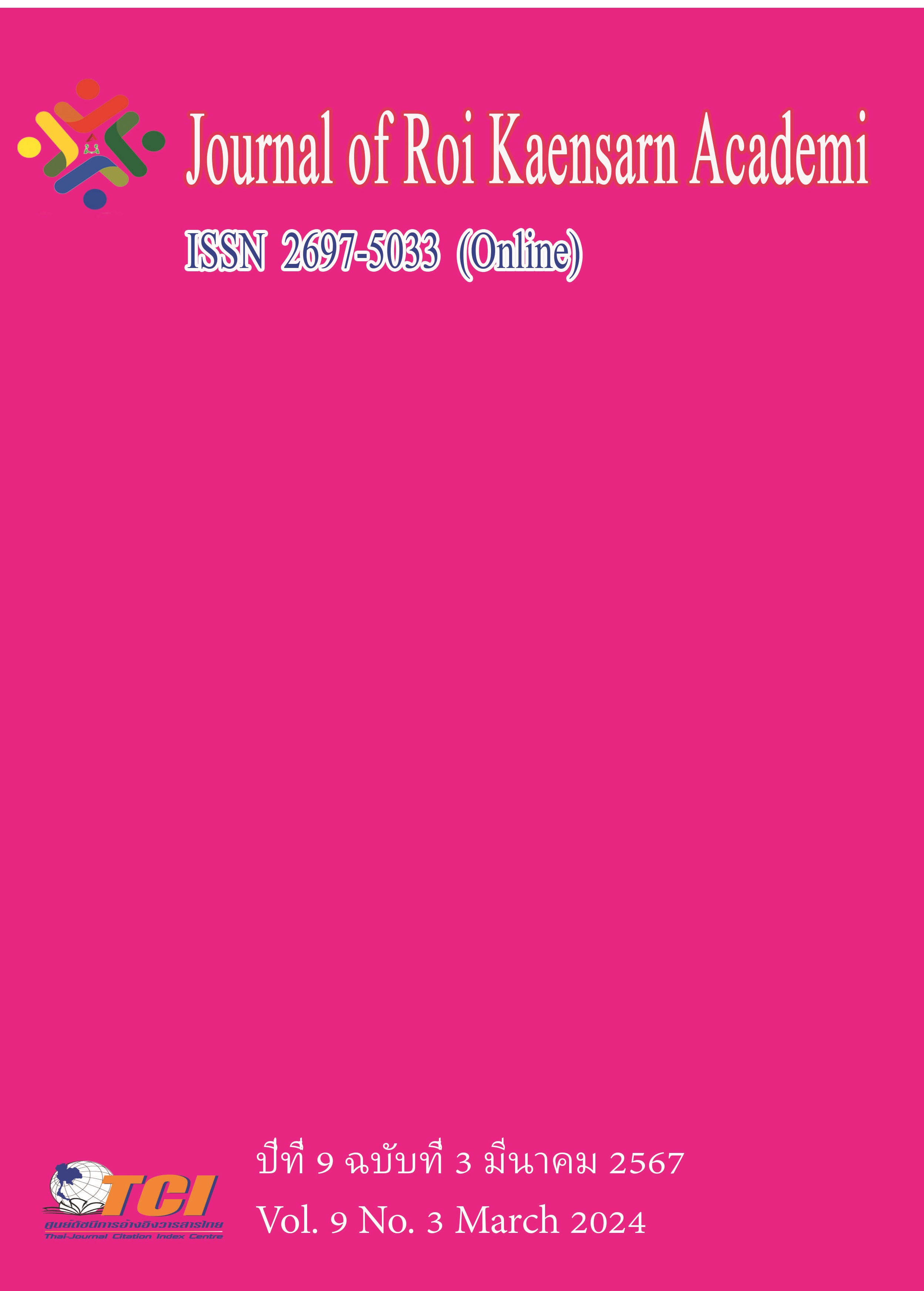The Current Perspectives and Piano Accompaniment of Guangdong Opera
Main Article Content
บทคัดย่อ
The Guangdong Opera is a significant musical composition that emphasises the importance of piano accompaniment in Chinese opera. This article aims to explain that the accompanist's role is to provide piano accompaniment that supports and validates the vocal rendition, elevating the vocalist's voice for close companionship and conversation. The Guangdong Opera is a traditional Chinese art form that emphasises the importance in Chinese opera. This article aims to explain that the role of accompanist in Cantonese opera vocal singing is to provide piano accompaniment, imitate the accompaniment of the band, support and assist vocal performance, and improve the singer's voice to achieve a tacit understanding.
A study suggests that computer-generated accompanists should adjust their performance to match that of a soloist, but it is crucial for the two musicians to collaborate in shaping the performance. Accompanists in educational institutions must possess specific expertise and competencies related to performing arts, such as breath control, resonance cavity, articulation, and respiration. The design and implementation of a piano-assisted automated accompaniment system can regulate the acoustic quality of a pianist performing opera, ensuring high-quality performances.
Article Details
เอกสารอ้างอิง
Barnes, D. (2020). Music Direction and Piano Accompaniment in Musical Theatre: A Practical Guide. (Master of Arts) Research. College of Arts and Humanities at the University of Central Florida. Orlandohttps://stars.library.ucf.edu/ etd2020/1574
Butler, A., Lind, V. L., & McKoy, C. L. (2007). Equity and access in music education: Conceptualizing culture as barriers to and supports for music learning. Music Education Research, 9 (2), 241-253.
CAI, L. Y. (2003). A Preliminary study on the music accompaniment art of Cantonese opera. Southern Red Bean, 5 (03),37-38.
Cantonese Opera Performance. (2015, January 26). Yuejuopera. Available from: http://www. yuejuopera.cn/yjjs/ysts/wjby/
Feng, Y. (2018). The technical characteristics of piano accompaniment in Chinese national vocal music works. Yuefu New Sound (Journal of Shenyang Conservatory of Music) 3 (02),104-113.
Gong, H. (2022). Problems and Countermeasures of the Popularization of Cantonese Opera Culture in Colleges. In SHS Web of Conferences, (Vol. 151, p. 01006). EDP Sciences.
Guangdong Opera Heritage. (2023). Guangdong Opera Heritage. In Wechat. 2023 June 12, Available from: https://mp.weixin.qq.com/s/LMjbroAXdk8UVCbbLo M76A
Guangzhou campus. (2022). Guangzhou campus. In Wechat. 2022 Oct 23, Available from: https://mp.weixin.qq.com/s/pOP-JwnK8ySOoUYbzypO4Q
Hasebe, M. (2012). Tone Control Apparatus and Method Using Virtual Damper Position. Acoustical Society of America Journal, 132 (2), 1246.
Jordanous, A., & Smaill, A. (2009). Investigating the role of score following in automatic musical accompaniment. Journal of New Music Research, 38 (2), 197-209.
Kaikai, L., & Sornyai, P. (2022). Application of Chu Wanghua’s Chinese Folk Song Arrangement in Piano Impromptu Accompaniment Teaching. Horizon, 4 (2), 140-152.
Kimoto, Y., Hirano, M., & Furuya, S. (2022). Adaptation of the corticomuscular and biomechanical systems of pianists. Cerebral Cortex, 32 (4), 709-724.
Kokotsaki, D. (2007). Understanding the ensemble pianist: A theoretical framework. Psychology of Music, 35 (4), 641-668.
Leung, B. W., & Leung, E. C. (2017). Teacher-artist partnership in teaching Cantonese opera in Hong Kong schools: Student transformation. In Critical essays in music education (pp. 281-306). Routledge.
Li, Z. (2018). Study on the important role of piano accompaniment in the performance of ethnic instruments. In the proceeding of the International Conference on Culture, Literature Arts&Humanities (ICCLAH 2018), 22 (5), 144-147.
Li,X. X. (2019). Hainan Qiong Drama Culture into the Classroom of the Current Situation and Implementation Path Research, Hainan Normal University, (Master’s Thesis)
Lihan, L., & Thothum, A. (2020). A Comparative Study of Piano Accompaniment in Chinese Folk Songs and Chinese Modern Songs (Doctoral dissertation, Mahasarakham University).
Lin, M., & Zhao, R. (2022). A Study of Piano-Assisted Automated Accompaniment System Based on Heuristic Dynamic Planning. Computational Intelligence and Neuroscience , 2022.
Long, C. M. & Xie, L. S. (2020). Study on the Classification and Artistic Characteristics of Qiong Opera, Art Criticism, 23 (2), 63-66.
Luo, Y., & Leung, B. W. (2023). Proposing an assessment framework for Cantonese operatic singing after reviewing the current practices in Hong Kong and Guangdong, China. Music Education Research, 25 (1), 102-117.
Sasanfar, J. K. (2012). Influence of aural and visual expressivity of the accompanist on audience perception of expressivity in collaborative performances of a soloist and pianist. (Doctor of Philosophy). Research. The Florida State University.
Sheldon, D. A., Reese, S., & Grashel, J. (1999). The effects of live accompaniment, intelligent digital accompaniment, and no accompaniment on musicians' performance quality. Journal of Research in Music Education, 47 (3), 251-265.
Wang, F. (2017). Beijing Opera Elements in Qigang Chen's Piano Concerto Er Huang. (Doctoral dissertation), The University of Southern Mississippi.
Xiaole, Z. (2021). The Construction and Thinking of Piano Teaching Innovation Mode. Art and Performance Letters, 2 (2), 156-159.
Xie, C. J. (2010). The Re-cognition and Thinking on Qiong Opera Singing Reform and Characteristics, Collected Dramas, 33 (2),69-74.
Ye, Y. (2022). Brief Analysis of the Singing Skills and Artistic Treatment of Choral Works with Chinese Traditional Opera Style. Forest Chemicals Review, 5 (02), 899-907.
Yung, B. (1983). Creative process in Cantonese opera III: The Role of Padding Syllables’, Ethnomusicology, 27 (3), pp. 439–456. https://doi.org/10.2307/850654
Yung, B. (1989). Cantonese opera: performance as creative process. Cambridge University Press.
Zhao, M. D. (2012). The Pitch of the Chinese Traditional Music Elements in the Inheritance and Innovation of Modern Music Creation. China Conservatory of Music. Available from: https://kns.cnki.net/kcms2/article/abstract?v=1fhXvtqifPJvsPtIbx5ZQW vG0qw Xy8TadXVZmLVwk73vYJYWDlwB7PqnTjLhmvTAVunykpCdxm48Jd4QFSdoAxEGvHvVaxXblYw6uaEuTj8QxNAJMgzy8UtUxcQGPFiLafp761ByhVba_05sitVtQ==uniplatform=NZKPTlanguage=CHS
Zheng, H., & Fang, X. (2021). A Study on Singing Techniques of Sheng and Dan in Chinese Qiong Opera. Asia-pacific Journal of Convergent Research Interchange (APJCRI), 6 (03), 151-161.
Zou, L. (2020, April). Application of data mining technology in music curriculum resources. In Journal of Physics: Conference Series,1533 (4), p.042031. IOP Publishing.

